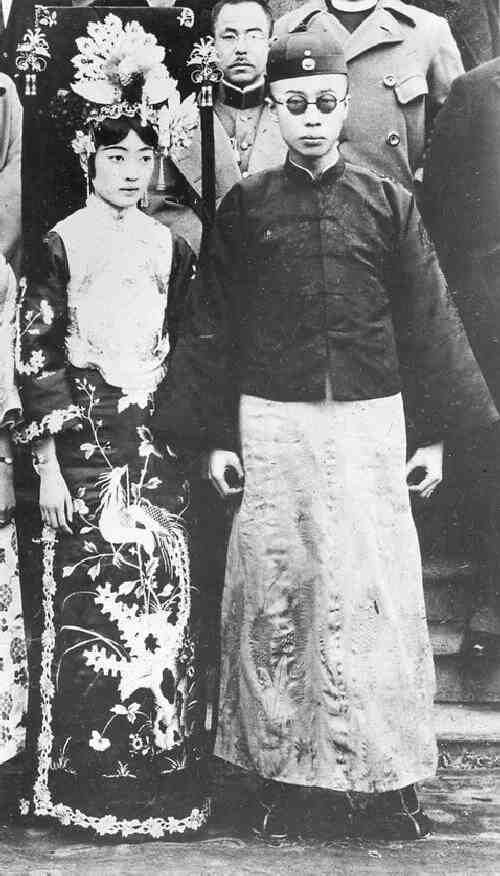

Chinese Emperors: Puyi--Tientsin

Figure 1.--This press photo shows the deposed boy emperor Puyi in the Japanese-contolledcport of Tientsin with his wife. They are in the garden of their home, surronded by Japanese army officers. The photograph was dated August 24, 1927. The two were married when they were very young. Note the beautiful embroidery on her dress.
|
|
Eventuually Puyi moved to the Japanese concession at Tientsin. Here he was beyound Nationalist control.
This had been the German treaty port, but was seized by the British and Japanese during World War I.
Nationalist China was attempting to get the Japanese to return the port to China.
Puyi at the time called this his "flight to freedom". He was to later see it as entering "the tiger's mouth". [Puyi] Tientsin was an important port and much more cosmopolitan than Beijing. The Japanese allowed Puyi to set up a court there. Japanese Army officers treated him with great defference. He was fed accounts of how the Chinese were abusing Manchuria. They told him that Japan was ready to assist him to take back what was rightfully his--the homeland of the Manchus. Puyi and his wife Elizabeth in Tientsin had very busy social lives, but they were not intimate. Puyi in fact was closer to Wen Hsiu, but she was not content with being a consort and demanded a divorce. While in Tientsin, Puyi learned that the Kuomintang forces had dynamited the Eastern Tombs of the Manchu rulers, including that of the Dowager Empress, looting and desecrating them (1928). He had been trained since childhood in the Chinese tradition of ancestor worship and extremely disturbed by the news. This turned him further against the Nationalist Chinese (Republic) and toward the Japanese. Up until this time he had resisted offers by the Japanese concerning Manchuria. This apparently helped convince him to actively work against the Nationalist Chinese and the Kuomintang. Mnchuria was of course the traditional homeland of the Manchu Dynaty.
Sources
Puyi.
HBRC

Related Chronolgy Pages in the Boys' Historical Web Site
[The 1880s]
[The 1890s]
[The 1900s]
[The 1910s]
[The 1920s]
[The 1930s]
[The 1940s]
[The 1930s]
[The 1940s]
[The 1950s]
[The 1960s]
[The 1970s]
[The 1980s]
Related Style Pages in the Boys' Historical Web Site
[Long pants suits]
[Knicker suits]
[Short pants suits]
[Socks]
[Eton suits]
[Jacket and trousers]
[Blazer]
[School sandals]
[School smocks]
[Sailor suits]
[Pinafores]
[Long stockings]
Navigate the Boys' Historical Clothing Web Page
[Return to the Main Puyi page]
[Return to the Main Manchu dynasty page]
[Introduction]
[Activities]
[Biographies]
[Chronology]
[Clothing styles]
[Countries]
[Bibliographies]
[Contributions]
[FAQs]
[Glossaries]
[Images]
[Links]
[Registration]
[Tools]
[Boys' Clothing Home]
Created: 11:40 PM 7/16/2008
Last updated: 11:40 PM 7/16/2008




